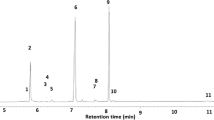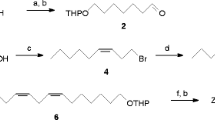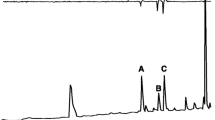Abstract
Heteropteran insects produce a series of volatile compounds from their scent glands that protect them from predators and parasites. These compounds also play roles in chemical communication that elicit aggregation, dispersal, and mating behaviors. Hygia lativentris (Coreidae) adults frequently aggregate on host plants. When disturbed, they quickly disperse with the release of a sour smell, suggesting that these bugs possess an alarm pheromone in their secretions. This adult secretion-induced dispersal has been examined with a laboratory assay. Hexanal, the predominant component of the adult secretion was identified as a component of the alarm pheromone by evaluation of the adult bug’s response time and escape distance from the chemical source. Physicochemical analyses with gas chromatography/mass spectrometry and nuclear magnetic resonance spectroscopy revealed that secretory components differed between nymphs and adults, and also during adult aging. Nymphs produced two unsaturated compounds, (E)-2-hexenal and (E)-4-oxo-2-hexenal, together with hexanal and 1-hexanol, which were found in all developmental stages. In adults, hexyl acetate was the major component of secretions within 3 days of emerging, while the amount of this ester decreased and those of hexanal, hexanoic acid, and hexanal trimer increased with aging. The decomposition of hexyl acetate into hexanal via 1-hexanol was attributed to the presence of esterases and alcohol dehydrogenases specifically found in adult secretory glands. In contrast, the formation of a hexanal trimer may be due to a non-enzymatic reaction under acidic conditions.






Similar content being viewed by others
References
Aldrich JR (1988) Chemical ecology of the Heteroptera. Annu Rev Entomol 33:211–238
Aldrich JR, Yonke TR (1975) Natural products of abdominal and metathoracic scent glands of coreid bugs. Ann Entomol Soc Am 68:955–960
Aldrich JR, Blum MS, Hefetz A, Fales HM, Lloyd HA, Roller P (1978) Proteins in a nonvenomous defensive secretion: biosynthetic significance. Science 201:452–454
Augé J, Gil R (2002) A convenient solvent-free preparation of 1,3,5-trioxanes. Tetrahedron Lett 43:7919–7920
Baker JT, Blake JD, MacLeod JK, Ironside DA, Johnson IC (1972) The volatile constituents of the scent gland reservoir of the fruit-spotting bug, Amblypelta nitida. Aust J Chem 25:393–400
Blatt SE, Borden JH, Pierce HD Jr, Gries R, Gries G (1998) Alarm pheromone system of the western conifer seed bug, Leptoglossus occidentalis. J Chem Ecol 24:1013–1031
Blum MS (1961) The presence of 2-hexenal in the scent gland of the pentatomid Brochymena quadripustulata. Ann Entomol Soc Am 54:410–412
Borges M, Aldrich JR (1992) Instar-specific defensive secretions of stink bugs (Heteroptera: Pentatomidae). Experientia 48:893–896
Calam DH, Youdeowei A (1968) Identification and functions of secretion from the posterior scent gland of fifth instar larva of the bug Dysdercus intermedius. J Insect Physiol 14:1147–1158
Eisner T, Eisner M, Siegler M (2005) Secret weapons. Defenses of insects, spiders, scorpions, and other many-legged creatures. Belknap Press of Harvard University Press, Cambridge
Eliyahu D, Ceballos RA, Saeidi V, Becerra JX (2012) Synergy versus potency in the defensive secretions from nymphs of two pentatomomorphan families (Hemiptera: Coreidae and Pentatomidae). J Chem Ecol 38:1358–1365
Farine J-P, Everaerts C, Brossut, R, Le Quére J-L (1993) Defensive secretions of nymphs and adults of five species of Pyrrhocoridae (Insecta: Heteroptera). Biochem Syst Evol 21:363–371
Fávaro CF, Santos TB, Zarbin PHG (2012) Defensive compounds and male-produced sex pheromone of the stink bug, Agroecus griseus. J Chem Ecol 38:1124–1132
Horvat RJ, Mcfadden WH, Ng H, Lane WG, Shepherd AD (1966) Identification of 2,4,6-trialkyl-1,3,5-trioxanes from autoxidized methyl linoleate by mass spectrometry. J Am Oil Chem Soc 43:350–351
Ishiwatari T (1976) Studies on the scent of stink bugs (Hemiptera: Pentatomidae) II. Aggregation pheromone activity. Appl Entomol Zool 11:38–44
Leal WS, Panizzi AR, Niva CC (1994) Alarm pheromone system of leaf-footed bug Leptoglossus zonatus (Heteroptera: Coreidae). J Chem Ecol 20:1209–1216
Lockwood JA, Story RN (1985) Bifunctional pheromone in the first instar of the southern green stink bug, Nezara viridula (L.) (Hemiptera: Pentatomidae): its characterization and interaction with other stimuli. Ann Entomol Soc Am 78:474–479
Millar JG (2005) Pheromones of true bugs. Top Curr Chem 240:37–84
Mizoguchi A, Mori N, Nishida R, Kuwahara Y (2003) α-Acaridial a female sex pheromone from an alarm pheromone emitting mite Rhizoglyphus robini. J Chem Ecol 29:1681–1690
Moraes MCB, Pareja M, Laumann RA, Borges M (2008) The chemical volatiles (semiochemicals) produced by Neotropical stink bugs (Hemiptera: Pentatomidae). Neotropical Entomol 37:489–505
Moreira JA, Millar JG (2005) Short and simple synthesis of 4-oxo-(E)-2-hexenal and homologs: pheromone components and defensive compounds of Hemiptera. J Chem Ecol 31:965–968
Nishimura K, Shimizu N, Mori N, Kuwahara Y (2002) Chemical ecology of astigmatid mites. LXIV. The alarm pheromone neral functions as an attractant in Schwiebea elongata (Banks) (Acari: Acaridae). Appl Entomol Zool 37:13–18
Noge K, Kato M, Iguchi T, Mori N, Nishida R, Kuwahara Y (2005) Biosynthesis of neral in Carpoglyphus lactis (Acari: Carpoglyphidae) and detection of its key enzyme, geraniol dehydrogenase, by electrophoresis. J Acarological Soc Jpn 14:75–81
Noge K, Kimura H, Abe M, Becerra JX, Tamogami S (2012a) Antibacterial activity of 4-oxo-(E)-2-hexenal from adults and nymphs of the heteropteran, Dolycoris baccarum (Heteroptera: Pentatomidae). Biosci Biotechnol Biochem 76:1975–1978
Noge K, Prudic KL, Becerra JX (2012b) Defensive roles of (E)-2-alkenals and related compounds in Heteroptera. J Chem Ecol 38:1050–1056
Prestwich GD (1976) Composition of the scents of eight East African hemipterans. Nymph-adult chemical polymorphism in coreids. Ann Entomol Soc Am 69:812–814
Prudic KL, Noge K, Becerra JX (2008) Adults and nymphs do not smell the same: the different defensive compounds of the giant mesquite bug (Thasus neocalifornicus: Coreidae). J Chem Ecol 34:734–741
Sakakura A, Kawajiri K, Ohkubo T, Kosugi Y, Ishihara K (2007) Widely useful DMAP-catalyzed esterification under auxiliary base- and solvent-free conditions. J Am Chem Soc 129:14775–14779
SAS Institute Inc. (2003) JMP 5.1, Cary, NC, USA
Soldi RA, Rodrigues MACM, Aldrich JR, Zarbin PHG (2012) The male-produced sex pheromone of the true bug, Phthia picta, is an unusual hydrocarbon. J Chem Ecol 38:814–824
Tsuyuki T, Ogata Y, Yamamoto I, Shimi K (1965) Stink bug aldehydes. Agric Biol Chem 29:419–427
Waterhouse DF, Gilby AR (1964) The adult scent glands and scent of nine bugs of the superfamily Coreoidea. J Insect Physiol 10:977–987
Yasuda T, Higuchi H (2012) Sex pheromones of Stenotus rubrovittatus and Trigonotylus caelestialium, two mirid bugs causing pecky rice, and their application to insect monitoring in Japan. Psyche 2012: Article ID 435640
Zarbin PHG, Fávaro CF, Vidal DM, Rodrigues MACM (2012) Male-produced sex pheromone of the stink bug Edessa meditabunda. J Chem Ecol 38:825–835
Acknowledgments
We thank Narumi Akahira and Kouhei Miura (Akita Prefectural University) for insect-collecting assistance. This work was supported by a Grant from the President-Sponsored Research Projects of Akita Prefectural University to K. N. The JNM-ECS400 spectrometer used in this study is a commonly shared instrument at Akita Prefectural University.
Author information
Authors and Affiliations
Corresponding author
Rights and permissions
About this article
Cite this article
Noge, K., Kakuda, T., Abe, M. et al. Identification of the Alarm Pheromone of Hygia lativentris and Changes in Composition during Development. J Chem Ecol 41, 757–765 (2015). https://doi.org/10.1007/s10886-015-0607-5
Received:
Revised:
Accepted:
Published:
Issue Date:
DOI: https://doi.org/10.1007/s10886-015-0607-5




